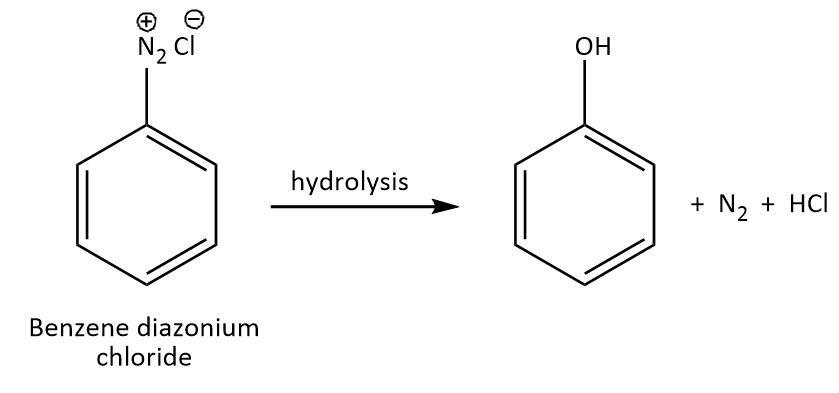
The by-product obtained during the production of phenol from Cummene industrially is:
A. acetaldehyde
B. acetic acid
C. acetone
D. acetyl halide
Answer
567k+ views
Hint: In a chemical reaction, the products other than the desirable one are called by-products.
Complete step by step answer:
We know that phenol can be prepared by various methods using different precursors. For example, chlorobenzene on treatment with ${\rm{NaOH}}$ under the conditions of \[{\rm{623 K and 320 atm}}\] gives sodium phenoxide that gives phenol on treatment with acid. Another example is diazonium salt of benzene, $\left( {{\rm{Ph}} - {\rm{N}}_2^ + {\rm{C}}{{\rm{l}}^ - }} \right)$ which can give phenol upon hydrolysis as per the following reaction:

As we can see that in addition to phenol, ${{\rm{N}}_2}\;{\rm{and}}\;{\rm{HCl}}$are also produced. We can say that in this reaction, phenol is the main product as it was desired and all the additional products are the by-products of this reaction as they were not specifically desired.
Now let’s discuss the industrial production of phenol from cummeneIsopropylbenzene, commonly known as cummene, is an aromatic hydrocarbon. It is usually found in crude oils and is significant for its varied applications including being used as solvent or blending component. The most important use of cumene is its use in phenol production.
We know that cummene upon getting oxidized in the presence of air givescummenehydroperoxide which can be shown as follows:

Cummenehydroperoxide gives phenol when treated with dilute acid which can be shown as follows:

As we can see that we are getting a byproduct as well which is acetone${\rm{C}}{{\rm{H}}_{\rm{3}}}{\rm{COC}}{{\rm{H}}_{\rm{3}}}$.
Thus, the correct option is C.
Note:
We have to be careful while using the terminology as main product and by-product and while writing the reactions for not just the number of atoms but the structure of the compound is very significant.
Complete step by step answer:
We know that phenol can be prepared by various methods using different precursors. For example, chlorobenzene on treatment with ${\rm{NaOH}}$ under the conditions of \[{\rm{623 K and 320 atm}}\] gives sodium phenoxide that gives phenol on treatment with acid. Another example is diazonium salt of benzene, $\left( {{\rm{Ph}} - {\rm{N}}_2^ + {\rm{C}}{{\rm{l}}^ - }} \right)$ which can give phenol upon hydrolysis as per the following reaction:

As we can see that in addition to phenol, ${{\rm{N}}_2}\;{\rm{and}}\;{\rm{HCl}}$are also produced. We can say that in this reaction, phenol is the main product as it was desired and all the additional products are the by-products of this reaction as they were not specifically desired.
Now let’s discuss the industrial production of phenol from cummeneIsopropylbenzene, commonly known as cummene, is an aromatic hydrocarbon. It is usually found in crude oils and is significant for its varied applications including being used as solvent or blending component. The most important use of cumene is its use in phenol production.
We know that cummene upon getting oxidized in the presence of air givescummenehydroperoxide which can be shown as follows:

Cummenehydroperoxide gives phenol when treated with dilute acid which can be shown as follows:

As we can see that we are getting a byproduct as well which is acetone${\rm{C}}{{\rm{H}}_{\rm{3}}}{\rm{COC}}{{\rm{H}}_{\rm{3}}}$.
Thus, the correct option is C.
Note:
We have to be careful while using the terminology as main product and by-product and while writing the reactions for not just the number of atoms but the structure of the compound is very significant.
Recently Updated Pages
Why are manures considered better than fertilizers class 11 biology CBSE

Find the coordinates of the midpoint of the line segment class 11 maths CBSE

Distinguish between static friction limiting friction class 11 physics CBSE

The Chairman of the constituent Assembly was A Jawaharlal class 11 social science CBSE

The first National Commission on Labour NCL submitted class 11 social science CBSE

Number of all subshell of n + l 7 is A 4 B 5 C 6 D class 11 chemistry CBSE

Trending doubts
Differentiate between an exothermic and an endothermic class 11 chemistry CBSE

10 examples of friction in our daily life

One Metric ton is equal to kg A 10000 B 1000 C 100 class 11 physics CBSE

Difference Between Prokaryotic Cells and Eukaryotic Cells

1 Quintal is equal to a 110 kg b 10 kg c 100kg d 1000 class 11 physics CBSE

State the laws of reflection of light




